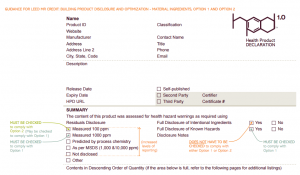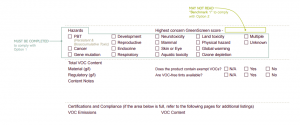If you’ve spent any time trying to track down Health Product Declarations, you’ve probably found them in a variety of sources – manufacturer websites, the HPD Collaborative, SmithGroups database, Building Green, amongst many other sites. What you’ll find are a wide variety of types of documentation, detailing material and chemical compositions to varying degrees. Now the Badger knows his barley from his hops, but I don’t have a Phd in chemical engineering. How do we make sure the HPD I’m looking at is compliant with the myriad of LEED v4 credit requirements?
In a nutshell, HPDs can help you earn Material Ingredient Reporting Option 1 – you’ll need 20 of them to earn the credit. The kicker is, you’ve got to make sure the HPDs you have meet the credit requirements. The good people at HPD Collaborative, who provide not only a framework for HPDs and help manufacturers build HPDs, provided some guidance on how the meet the LEED credit requirements.
There are two different HPD standards – v1 and v2 – and the output you’ll be reviewing differs between the older version and the newer version. Based on our experience, there are many more v1 HPDs out there, so we’ll start with those.
v1 HPDs
To qualify for this option, the HPD must include the following:
Summary
- Content assessed for health hazard warnings as required using Residuals Disclosure – measured to 1,000 ppm or 100 ppm must be checked
- Full Disclosure of Intentional Ingredients does not have to be checked o Full Disclosure of Known Hazards must be checked
- Hazards checklist must be completed
Content in Descending Order of Quantity
- Ingredient Name – may be “Unknown” or “Undisclosed”
- % Weight must be filled in for all ingredients
- Role – must be filled in for all ingredients
- Hazards – must be filled in for all ingredients
What does that look like on an actual HPD? Again, full credit for these images goes to the HPD Collaborative: (click images for larger view)
To start, in the Summary – the box Measured to 100 ppm or Measured to 1000 ppm MUST be checked – any of the other options do not meet the requirements. Additionally, the Full Disclosure of Known Hazards box MUST be checked.
In the Hazards section – this must be filled out. It cannot be left blank or it will not comply
Finally, under Content in Descending Order of Quantity, make sure : 1) Ingredient Name – may be “Unknown” or “Undisclosed”, 2) % Weight must be filled in for all ingredients, 3) Role – must be filled in for all ingredients and 4) Hazards – must be filled in for all ingredients.
v2 HPDs
Section 1: Summary o
- Content Inventory Threshold – 100 ppm and/ or 1,000 ppm must be checked; no other thresholds allowed (due to limits in the supply chain, consider submitting a Credit Interpretation Request when a nominal portion of the product is inventoried at a less stringent threshold level).
- Residuals and contaminants considered in X out of Y materials – there must be a general explanation of why or why not residuals and contaminants were or were not considered. There is no minimum number of “considered” materials for compliance.
- Characterized – must be “yes”
- Screened – must be “yes” except may be “no” when Inventory and Screening Notes must indicate that the only contents not Screened are regarded as Special Conditions by the HPDC and the inventory requirements posted in Emerging Best Practices have been followed.
- Identified – either “yes” or “no” may be checked o Inventory and Screening Notes – must include statement about Special Conditions when “No” is indicated for “Screened” above.
Section 2: Content in Descending Order of Quantity
- Material Notes – if not documented in Section 5, General Notes, Residual and contaminant consideration must be documented here for all materials; include statement about Special Conditions when relevant
- Substance Name – may be “Unknown” or “Undisclosed”
- ID – may be “Unknown” or “Undisclosed”
- Role – must be filled in for all contents
- Hazards – must be filled in for all contents
- Residual or contaminant – may be “Unknown” or “Undisclosed”
Next time you come across an HPD, double check it meets these requirements to ensure your MIRc4 Option1 success!





Be First to Comment